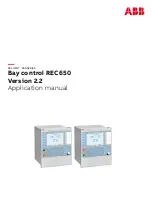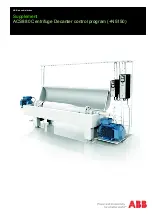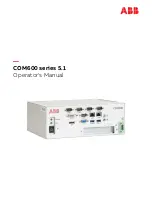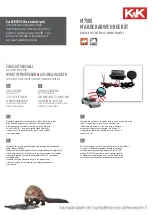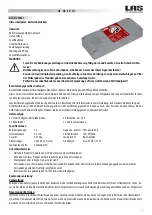
2
dc1768af
DEMO MANUAL DC1768A
QUICK START PROCEDURE
Demonstration Circuit 1768A is easy to set up to evaluate
the performance of the LTC3626. For proper measurement
equipment configuration, set up the circuit according to
the diagram in Figure 1. Before proceeding to test, check
that the shunts are inserted into the default locations: 1.2V
position of the output voltage header JP1, the SS posi-
tion of the soft-start/track header JP5, the FCM (Forced
Continuous Mode) position of the MODE header JP6, the
ON position of RUN header JP7, the 1MHz position of the
frequency header JP8, the EXT position of the I
TH
header
JP9, the SET/OFF position of the temperature set header
JP10, the OFF position of the temp. monitoring header
JP11, the OFF position of the output current monitoring
header JP12, and the OFF position of the input current
monitoring header JP13.
When measuring the input or output voltage ripple, care
must be taken to avoid a long ground lead on the oscillo-
scope probe. Measure the input or output voltage ripple
by touching the probe tip directly across the V
IN
or V
OUT
and GND terminals. See Figure 2 for proper scope probe
measurement technique.
With the 1768A set up according to the proper measure-
ment configuration and equipment in Figure 1, apply 6.3V
at V
IN
(Do not hot-plug V
IN
or increase V
IN
over the rated
maximum supply voltage of 20V, or the part may be dam-
aged.). Measure V
OUT
; it should read 1.2V (If desired, the
quiescent current of the circuit can be monitored now by
swapping the shunt in header JP7 into the OFF position.).
The output voltage should be regulating. Measure V
OUT
it
should measure 1.2V ±1% (1.188V to 1.212V).
Vary the input voltage from 3.6V to 20V and adjust the
load current from 0 to 2.5A. V
OUT
should regulate around
1.2V ±2% (1.176V to 1.224V). Measure the output ripple
voltage; it should measure less than 20mVAC. Set the input
voltage to 12V and the output current to any current less
than 1.25A. Observe the discontinuous mode of operation
at the switch node, and measure the output ripple voltage.
It should measure less than 50mV. Change the shunt
position on the MODE header from BM to FCM (Forced
Continuous Mode) and observe the voltage waveform at
the switch pins (the other side of the inductor from the
output). Verify the switching frequency is between 850kHz
and 1.2MHz (T = 1.17μs and 833ns), and that the switch
node waveform is rectangular in shape.
Insert the JP7 shunt into the OFF position and move the
shunt in the 1.2V output JP1 header into any of the two
remaining output voltage option headers: 1.8V (JP2) or
3.3V (JP3). Just as in the 1.2V V
OUT
test, the output volt-
age should read V
OUT
±1% tolerance under static line and
load conditions and ±1% tolerance under dynamic line and
load conditions ±2% total). Also, the circuit operation in
discontinuous mode will be the same.
Monitor the input and output currents, and the die tem-
perature, by changing the shunts on headers JP13, JP12,
and JP11, respectively. The currents and temperature can
even be limited using headers JP13, JP12, and JP10 – the
TSET header, and adjusting the values of resistors R12,
R13, and R14 (Consult the Input/Output Current and On-
Die Temperature Monitor and Limit section of the LTC3626
datasheets for more details.).
When finished, turn off the circuit by inserting the shunt
in header JP7 into the OFF position.












